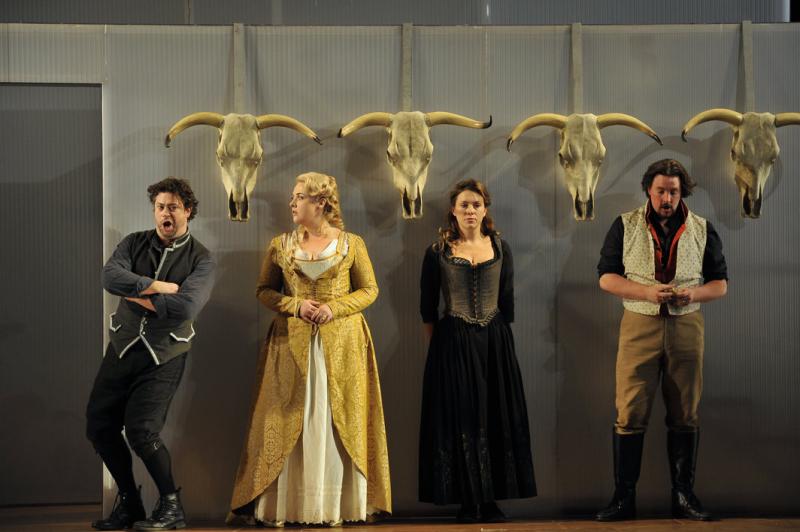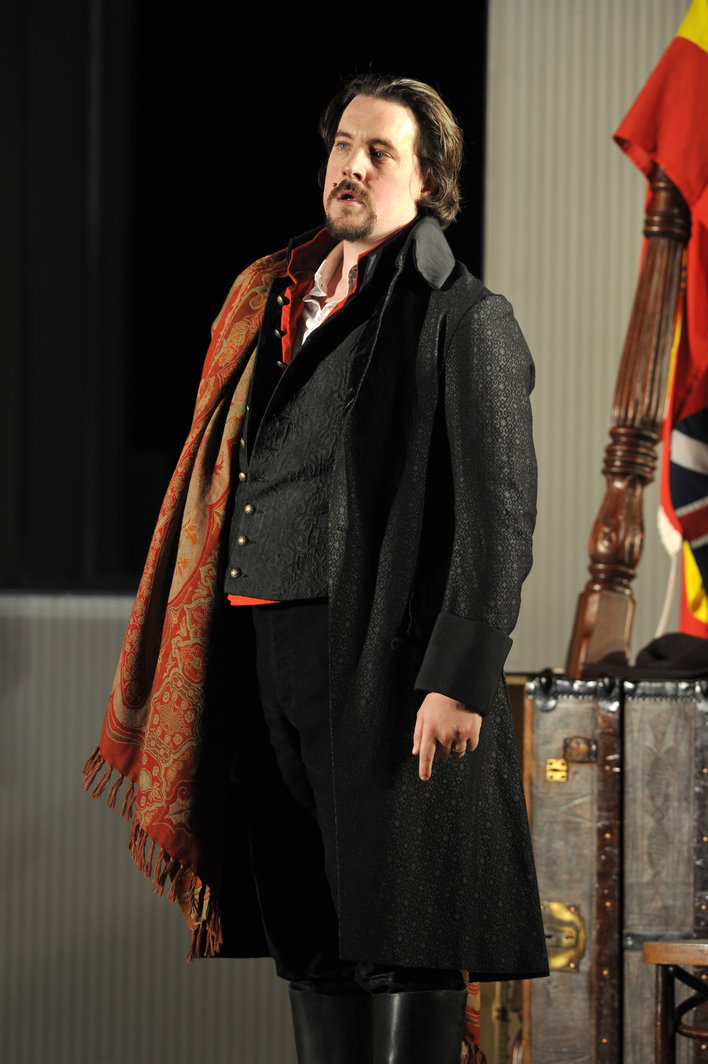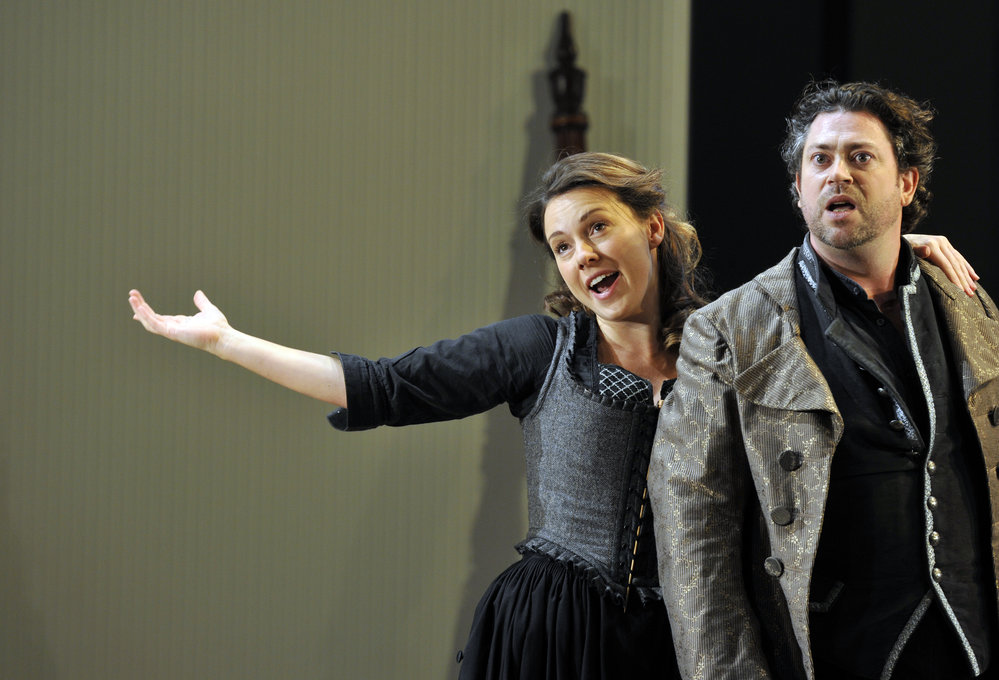The Marriage of Figaro, English National Opera | reviews, news & interviews
The Marriage of Figaro, English National Opera
The Marriage of Figaro, English National Opera
Fiona Shaw's Mozart makes a joyous return to the Coliseum

To take Figaro – the ultimate operatic assault on class distinctions and social hierarchies – and set it on a giant revolve is a gesture as wilful as it is elegant. Not only are divisions of above and below-stairs dissolved in this steadily circling world, but also those of background and foreground, onstage and offstage.
When we first encountered Shaw’s production in 2011 – all rams’ skulls and robust humour – it had a wit that emerged from an almost overwhelming attention to musical detail, gesture narrating score with clinging specificity. Three years on and the show has loosened up; less concerned with proving to us how well it understands the music, it now lives it with a gusto that’s purer Mozart than any amount of filigree fussiness.
This Figaro epitomises everything that ENO should be in a city that also houses the Royal Opera
It helps that this time round Shaw has a cast that’s pretty close to perfect – an ensemble of young singers bringing the same urgency and intensity to the situation as their characters. Last night saw an astonishing four role debuts. The Count (Benedict Nelson), Susanna (Mary Bevan), Figaro (David Stout) and Cherubino (Samantha Price) all took their parts for the first time – particularly striking in the case of Bevan who, just three years ago, was playing Barbarina in this same production.
The result is deliciously and joyously vivid, a show that sticks two (immaculately gloved) fingers up at all those who mutter darkly about London not being large enough to support two opera houses. This Figaro epitomises everything that ENO should be in a city that also houses the Royal Opera: a theatrical performance whose dramatic currency just happens to be song; an ensemble event in which voice is an extension of character rather than a replacement for it; an English-language production whose libretto translates the spirit instead of the text of the original.
 Jeremy Sams’ English libretto deserves a moment in the spotlight. Pirouetting verbally with the same skill as the productions’ visuals, it’s neat without ever getting too contrived. Punchlines always make their landings, rhymes unfold with just enough surprises to keep your wits about you, and above all it just feels natural (if your everyday dialogue were just that little bit sharper and funnier, that is).
Jeremy Sams’ English libretto deserves a moment in the spotlight. Pirouetting verbally with the same skill as the productions’ visuals, it’s neat without ever getting too contrived. Punchlines always make their landings, rhymes unfold with just enough surprises to keep your wits about you, and above all it just feels natural (if your everyday dialogue were just that little bit sharper and funnier, that is).
Shorn of its open-vowelled Italian, the opera takes on a different character. Just as the recitative becomes more clipped, more consonant-driven, so the action sharpens its bladed edge. Shaw’s comedy sits right on the edge of farce, and that in its truest sense not of pratfalls and bedroom antics (though there are plenty of those two) but of suppressed violence and rage. The revolution may find itself relocated to a domestic sphere here, but pins, letters and hats proves themselves no less deadly than any amount of weaponry.
This underlying violence is heightened by Benedict Nelson’s Count (pictured above), who suppresses as much as he releases, a man stalking the borderlands of his own civilised humanity. But even Nelson’s dominant presence meets its match in David Stout (pictured below with Bevan) – a likeable, comedic Figaro with more of the Barbiere about him than we might expect, something that’s mirrored across the production as a whole. The trade-off is a garden scene that lacks the stakes of some, whose slower pace and softer mood is dulled by the technicolour delight of all that has come before.
 This lack was less evident before, largely thanks to the quiet tragedy of Kate Valentine’s Countess. In Sarah-Jane Brandon’s hands she is – though strongly sung – a fond featherweight, not fully believable in her final rejection. In Price and Bevan however she has co-conspirators of anarchic delight. Price is a real find – gangling and charming, awkwardly loveable and with a legato you could balance your tea-cup on – and any superlatives should also include Lucy Schaufer’s feisty Marcellina and a very fine Barbarina from Ellie Laugharne. But the show belongs to Bevan.
This lack was less evident before, largely thanks to the quiet tragedy of Kate Valentine’s Countess. In Sarah-Jane Brandon’s hands she is – though strongly sung – a fond featherweight, not fully believable in her final rejection. In Price and Bevan however she has co-conspirators of anarchic delight. Price is a real find – gangling and charming, awkwardly loveable and with a legato you could balance your tea-cup on – and any superlatives should also include Lucy Schaufer’s feisty Marcellina and a very fine Barbarina from Ellie Laugharne. But the show belongs to Bevan.
Presented with the Critics’ Circle Award for Exceptional Young Talent (an award her sister Sophie also won in 2012) onstage after the performance, this felt a lot like the singer’s graduation – a promotion to a role she was made to play. Pert and pretty as any Susanna, under Shaw’s direction Bevan also has a no-nonsense vigour about her, and we more than believe her sly declaration that “women of my class don’t get headaches”. A singing actress of the most instinctive kind, Bevan renders specifics about voice irrelevant: this is a performance that must be judged as a whole.
Fiona Shaw’s Figaro matches Mozart’s blow for blow – a revival that’s lighter, tighter and brighter than the show’s first outing, and one that’s well worth coming back for. More importantly, though, it’s a production that anyone who’s never been to the opera should see. If this doesn’t convince them of the humour and humanity of this brilliant art-form, I really don’t know what will.
- The Marriage of Figaro is at English National Opera until 23 November, 2014
rating
Explore topics
Share this article
The future of Arts Journalism
You can stop theartsdesk.com closing!
We urgently need financing to survive. Our fundraising drive has thus far raised £49,000 but we need to reach £100,000 or we will be forced to close. Please contribute here: https://gofund.me/c3f6033d
And if you can forward this information to anyone who might assist, we’d be grateful.

Subscribe to theartsdesk.com
Thank you for continuing to read our work on theartsdesk.com. For unlimited access to every article in its entirety, including our archive of more than 15,000 pieces, we're asking for £5 per month or £40 per year. We feel it's a very good deal, and hope you do too.
To take a subscription now simply click here.
And if you're looking for that extra gift for a friend or family member, why not treat them to a theartsdesk.com gift subscription?
more Opera
 Orpheus and Eurydice, Opera Queensland/SCO, Edinburgh International Festival 2025 review - dazzling, but distracting
Eye-popping acrobatics don’t always assist in Gluck’s quest for operatic truth
Orpheus and Eurydice, Opera Queensland/SCO, Edinburgh International Festival 2025 review - dazzling, but distracting
Eye-popping acrobatics don’t always assist in Gluck’s quest for operatic truth
 MARS, Irish National Opera review - silly space oddity with fun stretches
Cast, orchestra and production give Jennifer Walshe’s bold collage their all
MARS, Irish National Opera review - silly space oddity with fun stretches
Cast, orchestra and production give Jennifer Walshe’s bold collage their all
 Káťa Kabanová, Glyndebourne review - emotional concentration in a salle modulable
Janáček superbly done through or in spite of the symbolism
Káťa Kabanová, Glyndebourne review - emotional concentration in a salle modulable
Janáček superbly done through or in spite of the symbolism
 Buxton International Festival 2025 review - a lavish offering of smaller-scale work
Allison Cook stands out in a fascinating integrated double bill of Bernstein and Poulenc
Buxton International Festival 2025 review - a lavish offering of smaller-scale work
Allison Cook stands out in a fascinating integrated double bill of Bernstein and Poulenc
 Tosca, Clonter Opera review - beauty and integrity in miniature
Happy surprises and a convincing interpretation of Puccini for today
Tosca, Clonter Opera review - beauty and integrity in miniature
Happy surprises and a convincing interpretation of Puccini for today
 Hamlet, Buxton International Festival review - how to re-imagine re-imagined Shakespeare
Music comes first in very 19th century, very Romantic, very French operatic creation
Hamlet, Buxton International Festival review - how to re-imagine re-imagined Shakespeare
Music comes first in very 19th century, very Romantic, very French operatic creation
 Falstaff, Glyndebourne review - knockabout and nostalgia in postwar Windsor
A fat knight to remember, and snappy stagecraft, overcome some tedious waits
Falstaff, Glyndebourne review - knockabout and nostalgia in postwar Windsor
A fat knight to remember, and snappy stagecraft, overcome some tedious waits
 Salome, LSO, Pappano, Barbican review - a partnership in a million
Asmik Grigorian is vocal perfection in league with a great conductor and orchestra
Salome, LSO, Pappano, Barbican review - a partnership in a million
Asmik Grigorian is vocal perfection in league with a great conductor and orchestra
 Semele, Royal Opera review - unholy smoke
Style comes and goes in a justifiably dark treatment of Handelian myth
Semele, Royal Opera review - unholy smoke
Style comes and goes in a justifiably dark treatment of Handelian myth
 Le nozze di Figaro, Glyndebourne review - perceptive humanity in period setting
Mostly glorious cast, sharp ideas, fussy conducting
Le nozze di Figaro, Glyndebourne review - perceptive humanity in period setting
Mostly glorious cast, sharp ideas, fussy conducting
 Fidelio, Garsington Opera review - a battle of sunshine and shadows
Intimacy yields to spectacle as Beethoven's light of freedom triumphs
Fidelio, Garsington Opera review - a battle of sunshine and shadows
Intimacy yields to spectacle as Beethoven's light of freedom triumphs
 Dangerous Matter, RNCM, Manchester review - opera meets science in an 18th century tale
Big doses of history and didaction are injected into 50 minutes of music theatre
Dangerous Matter, RNCM, Manchester review - opera meets science in an 18th century tale
Big doses of history and didaction are injected into 50 minutes of music theatre

Add comment